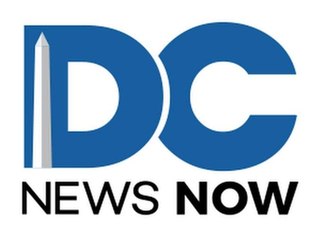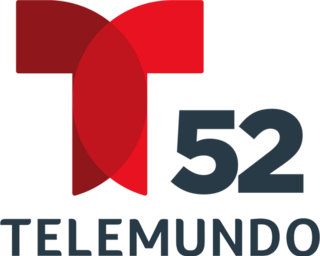
WSTR-TV, branded on-air as Star 64, is a television station in Cincinnati, Ohio, United States, affiliated with MyNetworkTV. It is owned by Deerfield Media, which maintains a local marketing agreement (LMA) with Sinclair Broadcast Group, owner of dual CBS/CW affiliate WKRC-TV, for the provision of advertising sales and other services. The two stations share studios on Highland Avenue in the Mount Auburn section of Cincinnati; WSTR's transmitter, Star Tower, is located in the city's College Hill neighborhood.
WFTY-DT is a television station licensed to Smithtown, New York, United States, serving Long Island and owned by TelevisaUnivision. Its main channel broadcasts the True Crime Network; it also rebroadcasts the main channels of its New York City–area Univision and UniMás stations, WXTV-DT and WFUT-DT, from its transmitter in Middle Island, New York.
WPSG, branded on-air as Philly 57, is an independent television station in Philadelphia, Pennsylvania, United States. It is owned by the CBS News and Stations group alongside CBS station KYW-TV. Both stations share studios on Hamilton Street north of Center City Philadelphia, while WPSG's transmitter is located in the city's Roxborough section.

WMYD is a television station in Detroit, Michigan, United States, affiliated with The CW. It is owned by the E. W. Scripps Company alongside ABC affiliate WXYZ-TV. Both stations share studios at Broadcast House on 10 Mile Road in Southfield, while WMYD's transmitter is located on Eight Mile Road in Oak Park.

KTXA is an independent television station in Fort Worth, Texas, United States, serving the Dallas–Fort Worth metroplex. It is owned by the CBS News and Stations group alongside Fort Worth–based CBS station KTVT. Both stations share primary studio facilities on Bridge Street, east of downtown Fort Worth, and advertising sales offices at CBS Tower on North Central Expressway in Dallas. KTXA's transmitter is located in Cedar Hill, Texas.

KDFI, branded on-air as More 27, is a television station licensed to Dallas, Texas, United States, broadcasting MyNetworkTV to the Dallas–Fort Worth metroplex. It is owned and operated by Fox Television Stations alongside Fox outlet KDFW. Both stations share studios on North Griffin Street in downtown Dallas, while KDFI's transmitter is located in Cedar Hill, Texas.

WFUT-DT is a television station licensed to Newark, New Jersey, United States, serving as the UniMás outlet for the New York City area. WFUT-DT is owned and operated by TelevisaUnivision alongside Paterson, New Jersey–licensed Univision station WXTV-DT. The stations share studios on Frank W. Burr Boulevard in Teaneck, New Jersey, and transmitter facilities at the Empire State Building in Midtown Manhattan. The programming of both stations and True Crime Network is simulcast to Long Island and southern Connecticut from WFTY-DT, broadcasting from Middle Island, New York.

WDCW, branded on-air as DCW 50, is a television station in Washington, D.C., serving as the local outlet for the CW television network. It is owned and operated by network majority owner Nexstar Media Group alongside Hagerstown, Maryland–licensed independent station WDVM-TV ; the two stations share studios on Wisconsin Avenue in Washington's Glover Park neighborhood. Through a channel sharing agreement with Univision station WFDC-DT, WDCW transmits using WFDC's spectrum from a tower in the Tenleytown area of Washington's Northwest quadrant.

KVEA is a television station licensed to Corona, California, United States, serving as the Los Angeles area outlet for the Spanish-language network Telemundo. It is owned and operated by NBCUniversal's Telemundo Station Group alongside KNBC. Both stations share studios at the Brokaw News Center in the northwest corner of the Universal Studios Hollywood lot off Lankershim Boulevard in Universal City, while KVEA's transmitter is located atop Mount Wilson.
WBPX-TV is a television station in Boston, Massachusetts, United States, airing programming from the Ion Television network. It is owned by the Ion Media subsidiary of the E. W. Scripps Company, which also owns Woburn-licensed Grit station WDPX-TV ; the two channels share the same TV spectrum. WBPX-TV and WDPX-TV are broadcast from a tower shared with WUNI and WWJE-DT on Parmenter Road in Hudson, Massachusetts.

WGBO-DT is a television station licensed to Joliet, Illinois, United States, serving as the Chicago-area outlet for the Spanish-language network Univision. It is owned and operated by TelevisaUnivision alongside Aurora-licensed UniMás station WXFT-DT. The two stations share studios at 541 North Fairbanks Court in the Streeterville neighborhood; WGBO-DT's transmitter is located atop the John Hancock Center.
WQHS-DT is a television station in Cleveland, Ohio, United States, broadcasting the Spanish-language networks Univision and UniMás. Owned and operated by TelevisaUnivision, it is the only full-power Spanish-language television station in the state of Ohio. WQHS-DT's studios and transmitter are located on West Ridgewood Drive in suburban Parma.
KPXG-TV is a television station licensed to Salem, Oregon, United States, broadcasting the Ion Television network to the Portland area. Owned and operated by the Ion Media subsidiary of the E. W. Scripps Company, the station has offices on Southwest Naito Parkway in downtown Portland, and its transmitter is located in the Sylvan-Highlands section of the city.

KSTS is a television station licensed to San Jose, California, United States, serving as the San Francisco Bay Area outlet for the Spanish-language network Telemundo. It is owned and operated by NBCUniversal's Telemundo Station Group alongside NBC outlet KNTV ; it is also sister to regional sports networks NBC Sports Bay Area and NBC Sports California. KSTS and KNTV share studios on North 1st Street in the North San Jose Innovation District; KSTS's transmitter is located on Mount Allison, and two of its main subchannels are also broadcast from the KNTV tower on San Bruno Mountain.

ON TV was an American subscription television (STV) service that operated in eight markets between 1977 and 1985. Originally established by National Subscription Television, a joint venture of Oak Industries and Chartwell Communications, ON TV was part of a new breed of STV operations that broadcast premium programming—including movies, sporting events, and concerts—over an encrypted signal on a UHF television station and leased decoders to subscribing customers. At its peak in 1982, ON TV boasted more than 700,000 customers—more than half of them in Los Angeles, its most successful market. However, the rapidly expanding availability of cable television, coupled with a recession, caused the business to quickly lose subscribers at the same time that Oak Industries was experiencing severe financial difficulties. Between March 1983 and June 1985, all eight operations closed.

Spectrum was an American subscription television channel that was owned and operated by United Cable. Existing during the early 1980s, the service was available in the Chicago and Minneapolis–St. Paul metropolitan areas. It was also available in some areas of Alaska, such as Fairbanks.
Preview was an American subscription television service that launched in 1980. Like its competitors, such as ONTV and SelecTV, Preview was a scrambled UHF subscription channel requiring a special set-top box to decode the signal.

Video Entertainment Unlimited (VEU) (also referred to as VEU Subscription TV) is a defunct American subscription television service that was owned by the Golden West Subscription Television, Inc. subsidiary of Golden West Broadcasters, which operated from May 1, 1980, until September 30, 1984. VEU aired a broad mix of feature films (including mainstream Hollywood blockbusters, lesser-known mainstream films, and softcore pornography) as well as sports events and specials.

WSNS-TV is a television station in Chicago, Illinois, United States, serving as the local outlet for the Spanish-language network Telemundo. It is owned and operated by NBCUniversal's Telemundo Station Group alongside NBC outlet WMAQ-TV ; it is also sister to regional sports network NBC Sports Chicago. WSNS-TV and WMAQ-TV share studios at the NBC Tower on North Columbus Drive in the city's Streeterville neighborhood; both stations are broadcast from the same transmitter atop the Willis Tower in the Chicago Loop.

Oak Industries, Inc. was an American electronics company that manufactured a variety of products throughout seven decades in the 20th century. In existence from 1932 to 2000, the company's business lines primarily centered around electronic components and materials, though the company made a high-profile and ultimately failed extension into communications media in the late 1970s and early 1980s. The firm was founded in Crystal Lake, Illinois, moving its headquarters to Rancho Bernardo, California, in the late 1970s and again to Waltham, Massachusetts, in 1990. Corning Inc. purchased Oak in January 2000 primarily for its Lasertron division, a manufacturer of lasers.














